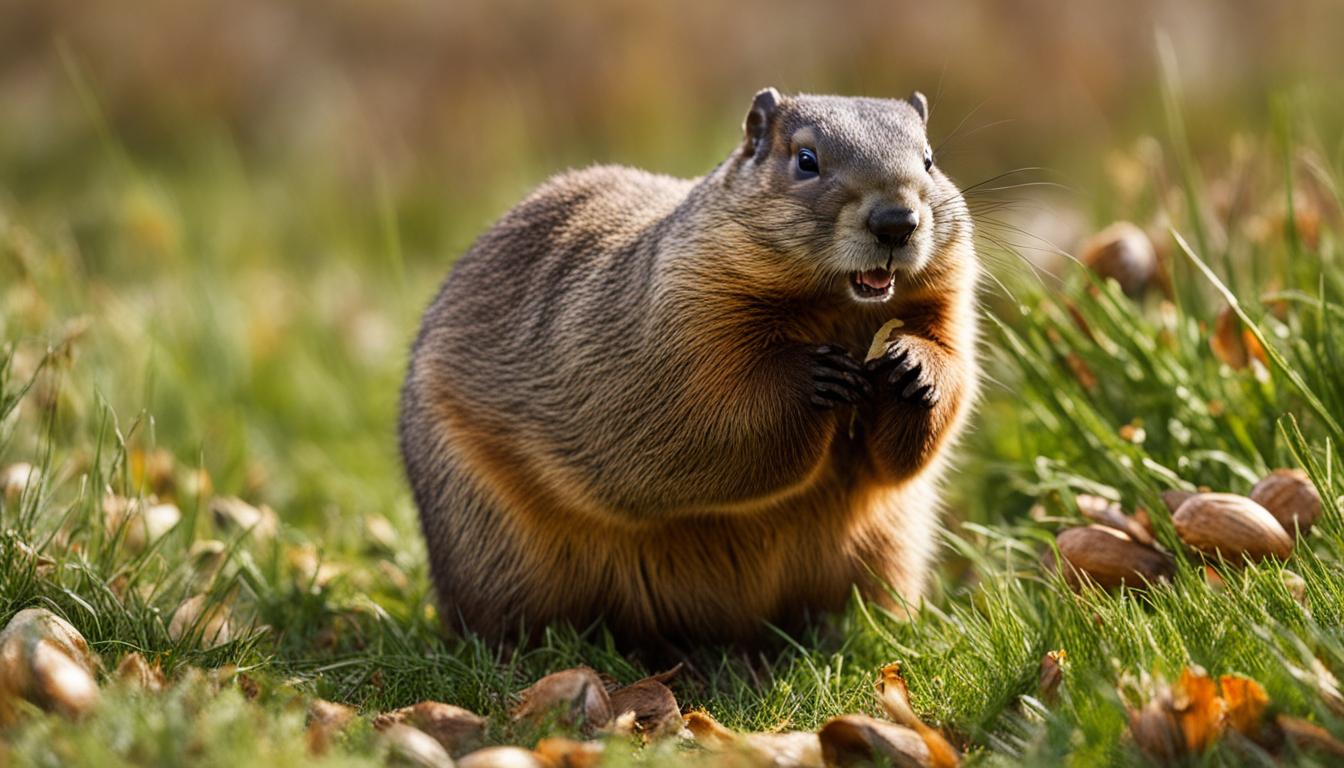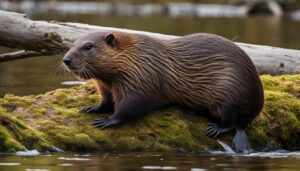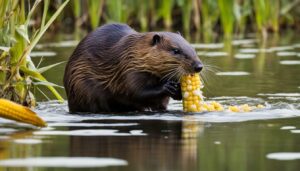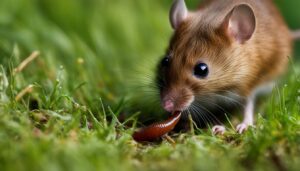Welcome to our article where we delve into the fascinating world of groundhogs and their dietary habits. Today, we’re exploring a question that has piqued the curiosity of many nature enthusiasts: do groundhogs eat nuts? Join us as we uncover the truth behind this nutty mystery!
Key Takeaways:
- Groundhogs have a diverse diet that includes nuts, foliage, fruits, grains, and cultivated crops.
- While groundhogs are primarily herbivorous, they may also consume eggs, bugs, and larger insects.
- Groundhogs have specific feeding habits and primarily eat during mornings, evenings, and even at night.
- Although groundhogs occasionally eat nuts, their main food source remains plants and green vegetation.
- Groundhogs can impact crops, posing challenges to farmers and gardeners due to their voracious appetites for plants.
Groundhogs’ Feeding Habits
Groundhogs have specific feeding habits that contribute to their survival and adaptation in their environment. They typically feed for a period of two hours at a time, focusing their feeding activities in the mornings and evenings. This pattern is consistent with their natural behavior and allows them to efficiently forage for food while still being aware of potential predators.
During hibernation, groundhogs’ feeding habits change significantly. As they prepare for the winter months, they primarily consume tree barks and small plant branches to build up their fat reserves. Protein is also essential for their survival during this time, so they may occasionally consume bugs and insects. However, it is important to note that groundhogs do not heavily rely on nuts as a significant part of their diet during hibernation.
Groundhogs’ Feeding Habits During Hibernation
During hibernation, groundhogs’ diet shifts to adapt to the limited food availability. They primarily consume tree barks and small plant branches, which provide them with the necessary nutrients and energy to sustain their hibernation period. While nuts are occasionally consumed, groundhogs do not rely heavily on them as a significant food source during this time.
Feeding Timetable and Foraging Behavior
Groundhogs have a feeding timetable in which they consume their meals in the mornings and evenings. This behavior allows them to efficiently search for food while minimizing the risk of predation during the more vulnerable periods of the day. Groundhogs may also engage in some nighttime feeding activities, further supporting their adaptive foraging behavior.
Food Preferences
While groundhogs have a diverse diet that includes nuts, foliage, fruits, and grains, their main food source is still plants. They prefer green vegetation and have a particular liking for various flowering plants and vegetables. Groundhogs do occasionally eat nuts, but it is important to understand that they do not store them like squirrels do. Instead, groundhogs mainly dig their burrows close to farms and gardens for easy access to their preferred food sources.
What Groundhogs Eat

Groundhogs have a diverse diet consisting of various vegetation, including grass, roots, leaves, bark, flowers, fruits, and vegetables. While they primarily feed on wild plants, groundhogs also consume cultivated crops and flowering plants commonly found in gardens and farms. Some of their preferred vegetables include alfalfa, lettuce, tomatoes, broccoli, carrots, melons, and cucumbers. While groundhogs do eat nuts occasionally, they do not store them like squirrels do. Their preference lies in green vegetation, and they often dig their burrows close to farms and gardens for easy access to food.
Table: Groundhog Diet Preferences
| Food Type | Examples |
|---|---|
| Vegetables | Alfalfa, lettuce, tomatoes, broccoli, carrots, melons, cucumbers |
| Fruits | Apples, berries, cherries, melons |
| Flowers | Daisies, sunflowers, marigolds, snapdragons |
| Grass | Clover, fescue, ryegrass |
| Bark | Tree barks from various species |
Despite their occasional nut consumption, groundhogs primarily rely on a diet rich in green vegetation. Their ability to adapt to different food sources and environments has contributed to their survival and population growth. However, their food preferences can pose challenges for farmers and gardeners as they can cause significant damage to crops.
Groundhogs play an essential role in their ecosystems by aiding in seed dispersal and maintaining balance in plant populations. They are adaptable creatures that have thrived in various habitats, including suburban areas. Their preference for green vegetation and proximity to human settlements make them a regular sight in gardens and farms.
Groundhogs’ Impact on Crops
Groundhogs’ voracious appetite for plants can pose a significant threat to crops, making them a nuisance for farmers and gardening enthusiasts. These furry creatures have a particular fondness for flowers, such as marigold and snapdragons, and are known to wreak havoc on standing plants. Whether it’s the vibrant colors or the tender leaves, groundhogs are attracted to and can destroy a variety of flowering plants.
In addition to flowers, groundhogs also consume a substantial amount of fruits, vegetables, and other plants. Their relentless feeding habits can result in significant damage to gardens and farms. They are not selective eaters and will indulge in a wide range of crops, including lettuce, tomatoes, broccoli, carrots, melons, cucumbers, and more. When it comes to their impact on crops, groundhogs can be quite destructive, requiring effective measures to protect valuable harvests.
Table:
| Plants | Groundhog Consumption |
|---|---|
| Flowers (e.g., Marigold, Snapdragons) | High |
| Fruits and Vegetables (e.g., Lettuce, Tomatoes, Carrots) | Significant |
| Other Crops | Varies |
As shown in the table above, groundhogs’ preference for flowers is high, indicating the need for extra caution when growing these plants in areas where groundhogs are prevalent. Additionally, their significant consumption of fruits and vegetables highlights the potential damage they can cause to these crops.
Groundhogs’ Hibernation and Seasonal Eating

As we’ve discussed earlier, groundhogs have a diverse diet that primarily consists of vegetation. However, their feeding habits and food preferences change during hibernation and throughout different seasons. During the winter months when groundhogs go into hibernation, their diet shifts to include tree barks, small plant branches, and insects. Nuts, although occasionally consumed, are not a significant part of their hibernation diet.
Before entering hibernation, groundhogs load up on food to build fat reserves that will sustain them through the winter. This food is mainly obtained from their preferred diet of green vegetation, fruits, and vegetables. Fruits and vegetables, in particular, are a significant part of their summer diet when they are readily available. This seasonal variation in food availability shapes the groundhogs’ eating habits and preferences.
To summarize, while groundhogs do consume nuts occasionally, they do not heavily rely on them as a substantial part of their diet. Instead, groundhogs primarily feed on vegetation, including fruits, vegetables, grass, and plant roots. The consumption of nuts by groundhogs is more incidental than a regular dietary choice.
Groundhogs’ Adaptations and Population Status

Groundhogs have developed various adaptations to survive in their natural habitats. One of their notable adaptations is their dietary preferences. Groundhogs are primarily herbivorous, with a preference for consuming green vegetation such as grass, roots, leaves, bark, flowers, fruits, and vegetables. While they do eat nuts occasionally, their main focus is on plant-based foods. This adaptation allows groundhogs to thrive in areas close to farms and gardens where they have easy access to their preferred food sources.
Groundhogs’ continuous feeding habits also serve as an important adaptation. Their voracious appetite helps them build up fat reserves before hibernation, ensuring their survival during the cold winter months when food is scarce. Additionally, their constant chewing helps keep their incisors trimmed. This is crucial for groundhogs as their incisors continue to grow throughout their lives, and maintaining the right length ensures they can effectively gather and consume their food.
In terms of population status, groundhogs have managed to thrive despite their impact on crops. This is partly due to a decrease in predators and their ability to adapt to seasonal variations in food availability. Groundhogs are listed as a “Least Concern” species by the International Union for Conservation of Nature (IUCN), indicating that their population is stable and not currently at risk. However, their impact on crops can still pose challenges for farmers and gardeners, requiring various deterrent measures to protect agricultural and horticultural interests.
Table: Groundhogs’ Adaptations and Population Status
| Adaptations | Population Status |
|---|---|
| Dietary preferences for plant-based foods | Stable population, listed as “Least Concern” species |
| Continuous feeding habits | Adaptable to seasonal variations in food availability |
| Maintenance of incisors through constant chewing | Decrease in predators allows for population growth |
Conclusion
After delving into the dietary habits of groundhogs, we can conclude that these furry creatures have a diverse menu that includes nuts, plants, fruits, and vegetables. While their primary food source is vegetation, groundhogs are not strictly herbivorous and may occasionally indulge in eggs, bugs, and larger insects.
During hibernation, groundhogs modify their feeding habits and rely on tree barks and small plant branches to sustain themselves. Although they do consume nuts, it is not a significant part of their overall diet. However, groundhogs have a voracious appetite for plants, which can pose challenges for farmers and gardeners who strive to protect their crops.
Despite their impact on agriculture, groundhog populations remain stable. They have adapted to seasonal variations in food availability and continue to thrive in North America. This adaptability, along with a decrease in predators, has allowed groundhog populations to be listed as a “Least Concern” species by the International Union for Conservation of Nature (IUCN).
FAQ
Do groundhogs eat nuts?
Yes, groundhogs include nuts in their diet, although they do not rely heavily on them. Their main food source is plants, and they consume a variety of vegetation such as grass, roots, leaves, bark, flowers, fruits, and vegetables.
What do groundhogs primarily eat?
Groundhogs primarily eat plants, including grass, roots, leaves, bark, flowers, fruits, and vegetables. They consume over a pound of plants per day, making them predominantly herbivorous.
In addition to plants, what else do groundhogs eat?
While groundhogs are predominantly herbivorous, they may also eat eggs, bugs, and larger insects. However, their main food source is still plants, and they can go for extended periods without consuming anything else.
Do groundhogs eat nuts during hibernation?
During hibernation, groundhogs’ diet changes, and they primarily consume tree barks, small plant branches, and occasional bugs for protein. They do not eat nuts extensively, but they load up on food before hibernation to build fat reserves.
Are groundhogs a threat to crops?
Yes, groundhogs can be a threat to crops due to their voracious appetite for plants. They have a particular liking for flowers and are known to destroy standing plants. Groundhogs consume a significant amount of fruits, vegetables, and plants, causing substantial damage to gardens and farms.
How do groundhogs adapt to seasonal variations in food availability?
Groundhogs adapt to seasonal variations in food availability by varying their diet. During the summer, fruits and vegetables play a significant role in their diet, while during hibernation, they rely on tree barks, small plant branches, and insects for sustenance.
Are groundhog populations stable?
Despite their impact on crops, groundhog populations remain stable. This is due to a decrease in predators and their ability to adapt to seasonal variations in food availability. Groundhogs are currently listed as a “Least Concern” species by the International Union for Conservation of Nature (IUCN).




